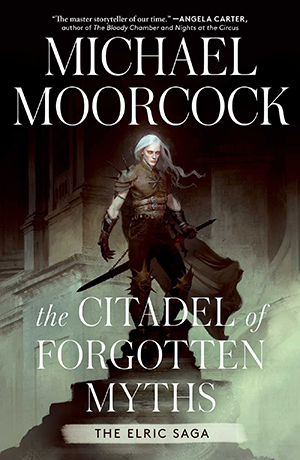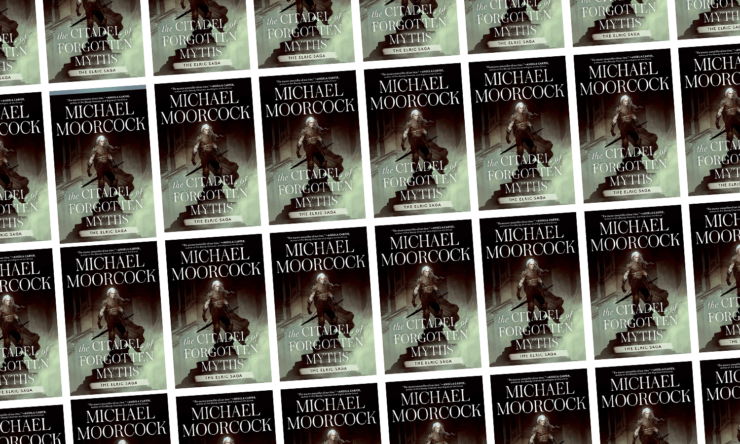Michael Moorcock has been writing Elric stories longer than most of his readers have been alive. He began the series before “fantasy” was an acknowledged genre and continues it in the era of Game of Thrones.
The first Elric of Melniboné story, “The Dreaming City,” debuted in the June 1961 edition of the British magazine Science Fantasy. Its author was just twenty-one years old. “The Dreaming City” was both an exemplar of the sword-and-sorcery tale and a subversion of the genre. Dragons soared, swords clashed, and empires fell, but Elric was anything but the typical hero. Cynical, sickly, ironic, and embittered, the albino “prince of ruins” devastated his home, caused the deaths of his allies, and, with his soul-devouring hellblade Stormbringer, slew the woman he’d begun a revolution to save.
A charitable reader would call Elric an antihero, a harsher one could label him the villain. The first Elric story was a hit, and nine more tales appeared over the next three years, until Moorcock brought Elric’s story to a fitting end with the novella “Doomed Lord’s Passing.” Although Moorcock never did unwrite Elric’s ultimate fate, neither the author nor his readers could leave the White Wolf for too long. Prequels and untold adventures followed; he cameoed in other Moorcock stories, showed up in both Marvel and DC comics, and visited Earth in a trilogy published at the turn of the millennium.
Sixty years after he woke “The Dreaming City” from its slumbers, readers still want more Elric. This year, Saga Press marked the albino’s anniversary by collecting eleven Elric novels into three omnibus volumes. And now, to cap things off, Moorcock has written a new Elric novel, The Citadel of Forgotten Myths.
Buy the Book


The Citadel of Forgotten Myths
For those who keep track of such things, The Citadel of Forgotten Myths takes place between The Bane of the Black Sword and Stormbringer, but the tale’s exact chronology matters less than the excitement it delivers. Longtime Moorcock readers know that chronology and causality are fluid in Elric’s multiverse, which forever loops around itself.
A restless Elric has, with the encouragement of his fiancée, traveled to the “World Below” in search of the secrets of his ancestry. As so often before, Elric is accompanied by his best friend, the swordsman Moonglum. As always, the pale swordsman and sorcerer bears Stormbringer, the vampiric sword that both preserves his life and destroys his soul. Elric and the few remaining Melnibonéans are not human; their ancestors include a race of dragons called the Phoorn. How did humans and dragons come together? What does this mean for their descendants? And might Elric find a cure for the debility that leaves him dependent on Stormbringer? The quest for answers will lead the companions across the ocean, through the bloody depths of a slaver’s castle, into the depths of an abandoned city in a treacherous jungle, on to an apparently utopian city, and, finally, to the interior of a volcanic mountain that hides an abominable secret. In other words, The Citadel of Forgotten Myths promises a classic Elric adventure.
When the first Elric stories arrived, relatively few fantasy stories made their way into book form without beginning as serials or individual stories. The early Elric novels were “fix-ups,” and so too is The Citadel of Forgotten Myths. The first two segments of the book were previously anthologized as “Red Pearls” and “Black Petals” about a dozen years ago. I could easily have mistaken them for vintage 1960s Elric: They have the same swiftness, the same violence, the same high spirits and high adventure. Elric and Moonglum slay armies’ worth of nameless foes, face fell beasts, explore ruined cities, and discover willing female companionship.
Moorcock, a subtle literary writer when he wants to be, lets loose; in these stories, he rarely goes a page without an exclamation mark. When Elric summoned an ancient crocodile demon to assist him in battle against a demonic plant monster, I grinned. When he unsheathed his howling blade and shouted “blood and souls for Arioch,” I cheered. It may not be in the best taste, but it’s great fun.
The third part of The Citadel of Forgotten Myths comprises two-thirds of the novel and introduces most of the book’s new, previously unpublished, material. It also introduces most of the book’s problems. Perhaps it was decided that a too-short novel wouldn’t sell and that the author must reach the three-hundred-page mark? Or perhaps the editors were too busy and the deadlines were too tight for a thorough edit? Whatever the case may be, the third section of the novel disappoints. Characters talk past each other in soliloquies peppered with rhetorical questions; again and again they ponder the same questions in near-identical words. Errors of continuity and copyediting abound. Twice in two pages, Stormbringer flies back to Elric’s outstretched hand after a long separation. We’re told that the majestic temple atop the city of Kirinmoir has a “silver dome crowning everything.” Just a few paragraphs later, Elric and Moonglum admire the “deep reflective blue and gold of the dome.” Elric’s poor eyesight is mentioned several times, but the albino sorcerer is able to instantly recognize an armored foe in the midst of an army hundreds of meters beyond and below him. Ramada Sabaru, a fierce warrior whose name evokes a suburban car dealership, is first “the Golden Wizard” and every time thereafter “the Golden Warlord.” At the story’s climax, the novel slews away from its protagonists for thirty confusing pages inside the deteriorating mind of a chaos goddess.
My disappointment with the editing and concerns with the pacing aside, I had a great deal of fun revisiting Elric and his world. Though it’s easy to imagine a more sleek and speedy version of this novel, I can hardly complain. To receive another Elric tale—and a full-length one at that—feels like a gift, and it was a pleasure to spend time with these characters for the first time in over a decade. Longtime sword-and-sorcery fans will enjoy references to past Elric adventures and to other installments of Moorcock’s Eternal Champion sequence; obsessives like myself could spend hours poring over the many references and allusions to everything from the Runestaff novels to the Second Aether sequence. I wouldn’t advise new readers to begin here, but for the Elric addicts, who feed off these stories like Stormbringer feeds off its victims’ souls, The Citadel of Forgotten Myths is essential. Long may the Prince of Ruins reign.
The Citadel of Forgotten Myths is published by Gallery / Saga Press.
Matt Keeley reads too much and watches too many movies. You can find him on Twitter at @mattkeeley.










